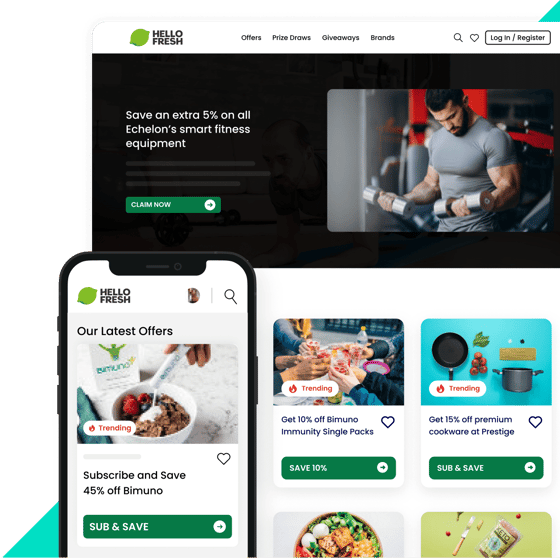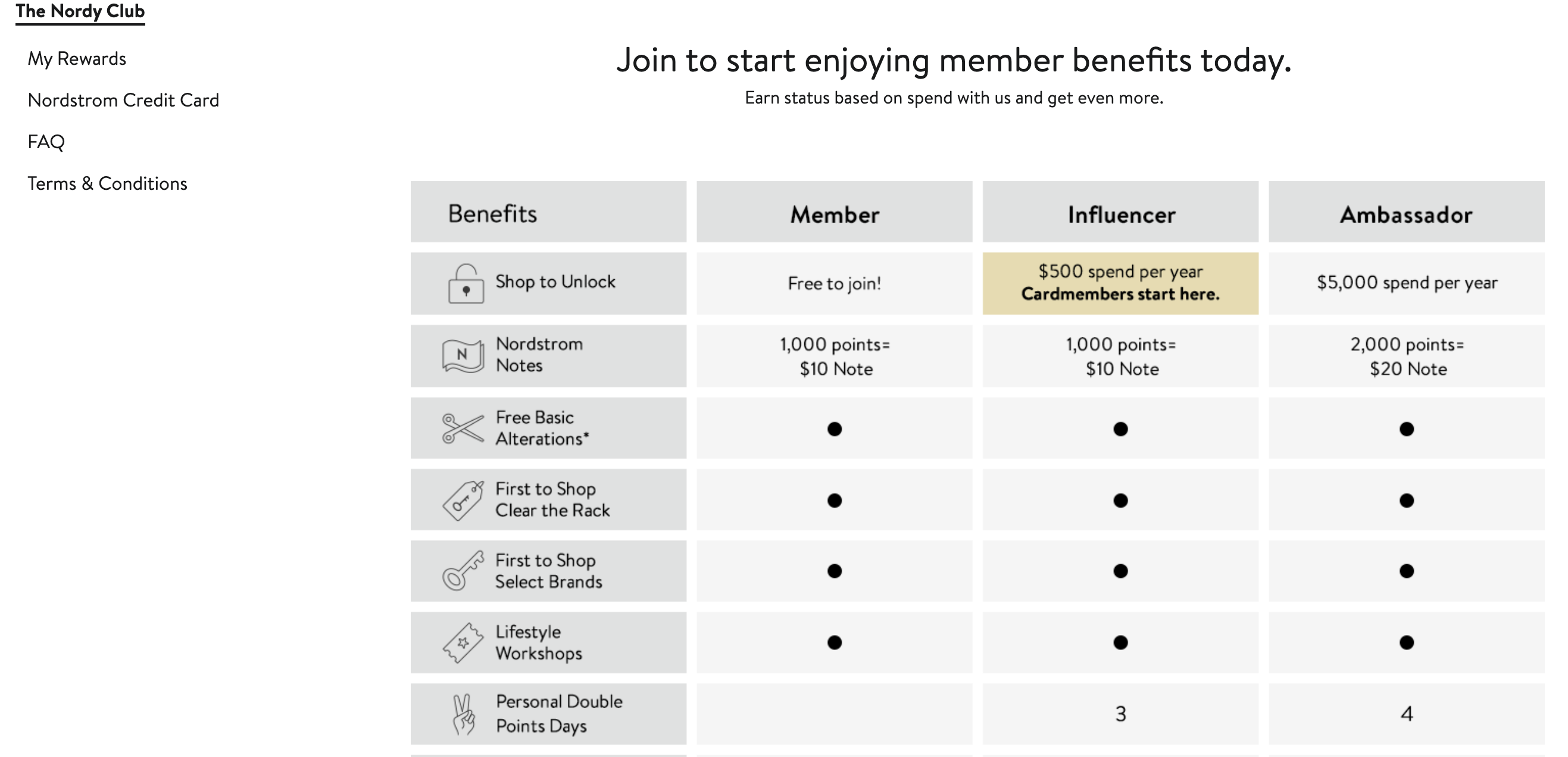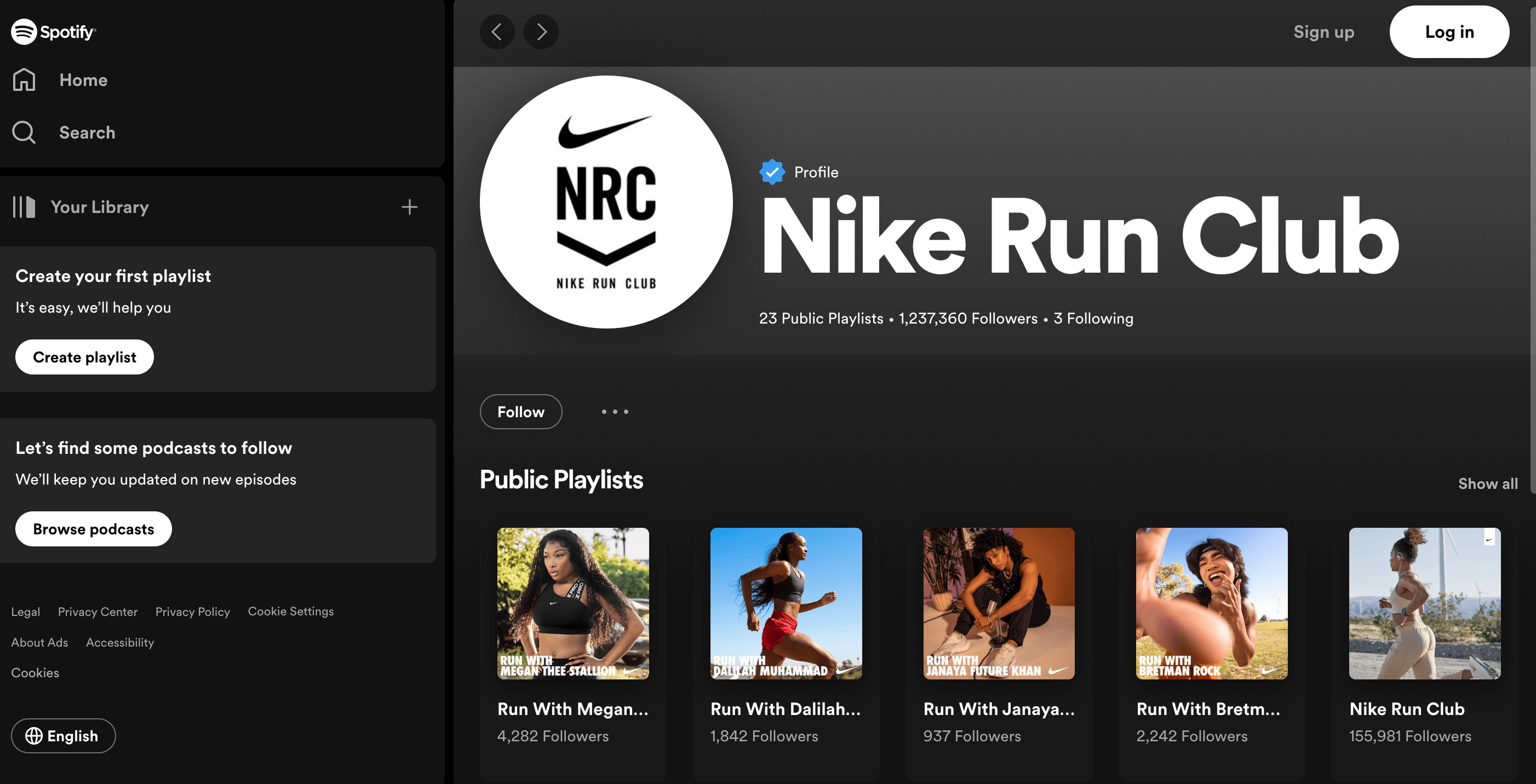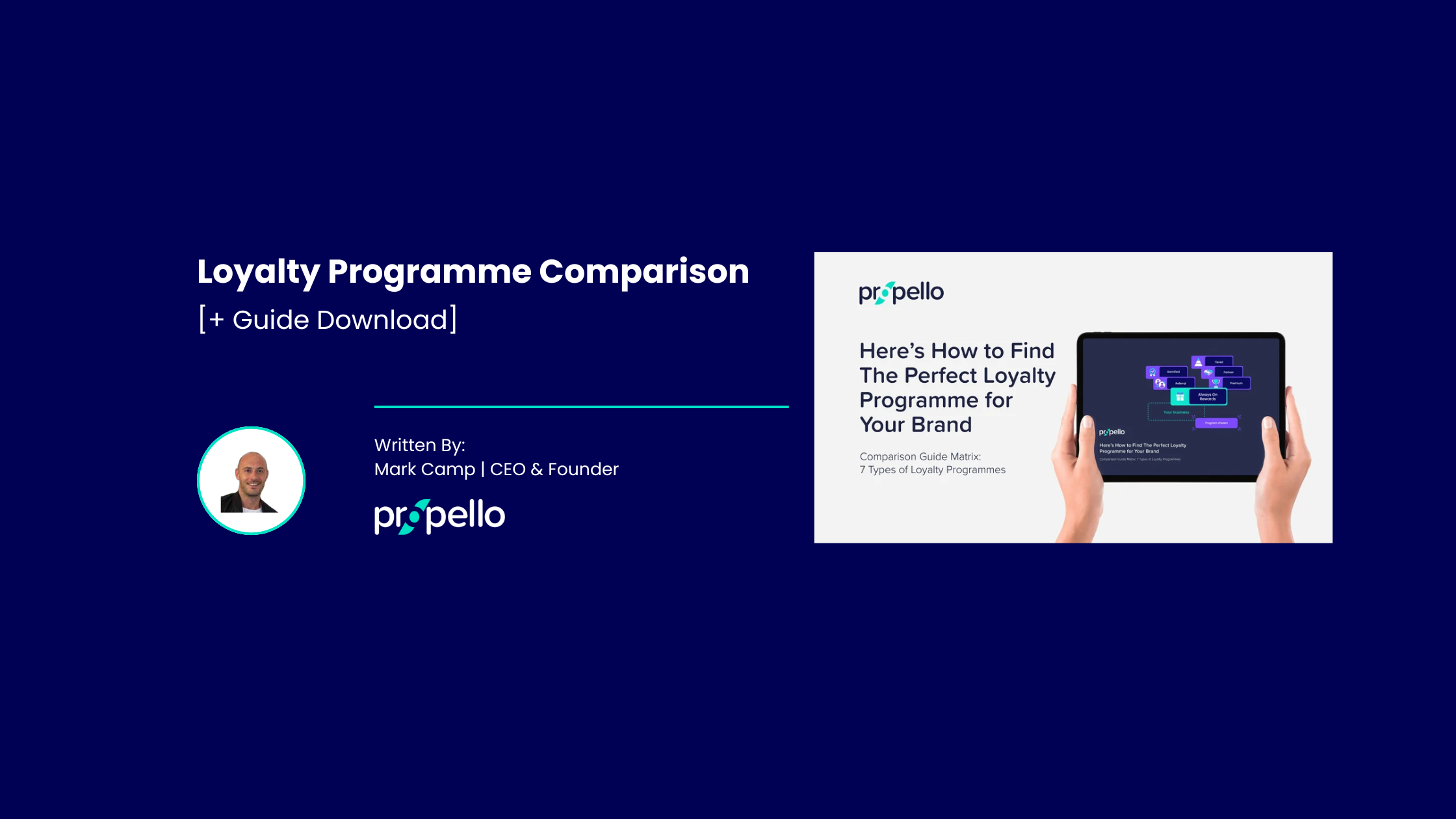Welcome to our latest blog, where we’ll be breaking down ten different types of loyalty programmes. If you’re considering a loyalty solution but you’re not sure where to start, you’re in the right place. Each section includes:
-
A brief overview of the programme and its benefits.
-
Whether the programme works well in your sector.
-
If it aligns with your business goals.
-
Which demographics it works best for.
-
Challenges associated with the loyalty programme.
By the end of this article, you should be one step closer to picking the right type of loyalty programme for your business.
Contents:
1) Always On Loyalty Programmes
2) Earn & Burn Loyalty Programmes
4) Premium-based Loyalty Programmes
6) Gamified Loyalty Programmes
7) Referral Loyalty Programmes
9) Value-Based Loyalty Programmes
10) Omnichannel Loyalty Programmes

Download the Customer Loyalty Programme Comparison Guide to find the right loyalty programme for your brand.Visit this blog for loyalty programme examples
Key Takeaways
-
Loyalty programmes help brands build bonds with their customers. Emotionally engaged customers have been shown to spend 60% more each year.
-
Always On are ideal starting points for businesses new to loyalty, offering simple set up and clear value to customers.
-
Tiered and Premium programmes work best for businesses with higher-value products or services, helping to identify premium customers and encourage increased spending.
-
Gamification and Value-based programmes focus on emotional connection and engagement outside of transactions. Usually, younger demographics resonate best with these types.
-
Hybrid programmes combine at least two different programmes. This offers greater flexibility but requires more resources to implement and maintain.
-
Omni-channel programmes meet the modern expectations of consumers, highly accustomed with seamless experiences.
1) Always On Loyalty Programmes (Instant Reward Programmes)
Always On Loyalty Programmes (AKA Instant Rewards Programmes) are ideal for most businesses. They can influence customer buying behaviour using data insights. Conditional rewards can be set up to push customers towards specific actions like contract renewal, upgrading memberships, or brand advocacy.
Customers can access their Instant Rewards as long as they stay subscribed to the loyalty programme and remain a customer. Incentives usually include discounts on:
-
The weekly shop
-
Events
-
Day outs
-
Holiday bookings
-
Tech goods
-
Hospitality
-
Fashion and more
Businesses with low purchase frequencies (for example subscription-based and membership organisations) also benefit from Always On Loyalty Programmes as they keep customers engaged between purchases.

Healthy meal kit subscription business, HelloFresh, offers it's members a range of relevant rewards, such as money of cookware and savings on fitness equipment, through complimentary partner brands.
Do Always On Loyalty Programmes Work Well in Your Sector?
Always On Programmes work well in most industries. They are highly flexible, universal in their appeal, and quite simple to set up. Making them particularly ideal for new businesses or more established enterprises that are just starting out with building loyalty.
Do Always On Loyalty Programmes Align with Your Goals?
If you want to improve customer retention, engagement, and advocacy, an Always On Loyalty Programme is an excellent choice. It can serve as a starter pack for building customer loyalty. One that with time, you can develop and shape.
-
Need a scalable solution that rewards growing audiences without incurring extra spend for your business?
-
Want to constantly engage and delight your customers, even outside of the sales cycle?
-
Are your top priorities to increase retention, engagement, upsell and cross-sell conversions, revenue and lifetime value?
An Always On Loyalty Programme might just be the right starting point for you. Let’s look at demographics.
Do Demographics Play A Role in Always On Loyalty Programmes?
Receiving rewards has universal appeal. For the most part, Instant Rewards should resonate with your customer base. That said, there are caveats. Your incentives and benefits need to be compelling enough. Customers expect tangible value, offsetting the cost of the weekly shop.
Should you combine an Always On Loyalty Programme with another type, you should reconsider demographics. Some loyalty programme types are better suited to particular age groups, personal circumstances, and profiles.
Challenges of Always On programmes
-
Whilst Always On Loyalty Programmes are typically the most simple to launch, they have their own challenges. At the very least, you’ll need:
-
A partner network offering a variety of rewards that are compelling and relevant to your customers.
-
Personnel with loyalty programme management experience to scale your in-house solution to growing audiences.
-
Technical personnel to build a seamless and secure experience.
-
A thorough understanding of the customer loyalty ladder, in order to deliver the right reward, at the right time, to the right customer.
Remember, we said building an Always On Loyalty Programme is simple. Not easy.
2) Earn & Burn Loyalty Programmes
Earn and burn or point-based loyalty programmes are perhaps the most recognisable customer loyalty strategy. A well-known example is Starbucks Rewards.
For every purchase a customer makes, they earn points which they can save and burn (redeem) in return for valuable rewards. Transactional and straightforward, points-based loyalty programmes increase purchase frequency as long as the value of rewards keeps increasing. Satisfied customers are incentivised to repeat purchases, promoting a healthier bottom line.
.png?width=860&height=339&name=Starbucks%20rewards%20(1).png)
Do Earn & Burn Loyalty Programmes Work Well in Your Sector?
Many businesses choose point programmes due to the simplicity and speed of their implementation. New businesses with simple purchase transactions are ideal. Point systems should work well regardless of industry or sector, as long as customers regularly buy products.
Do Points-Based Loyalty Programmes Align with Your Goals?
A points-based loyalty programme is great for businesses that want a quick, cost-effective set up. Here’s some further examples of well-aligned goals:
-
You want to increase your purchase frequency rate.
-
You want to improve your brand’s perceived value.
-
You want an easy-to-budget solution.
-
You want a loyalty programme that’s quick to launch.
-
You want a programme that’s simple to manage and straightforward for customers.
The case for a points-based loyalty programme increases with each yes. But before you make that decision, let’s consider demographics.
Do Demographics Play A Role in Points-Based Loyalty?
Earn and burn works well with all age groups familiar with your brand. Just make sure to keep your reward earning rules simple. A good rule of thumb; reward customers with 1 or 10 points for every 1 spent unit of currency. Avoid criterias like “£5.00 spend gives you 72 points”. Straightforward earning criterias makes tracking easier and improves customer usability across all demographics.
Challenges of Earn & Burn
Like Always On Loyalty, Earn & Burn Loyalty Programmes come with their own set of challenges. Unlike Always On however, points-based challenges centre around differentiation, lower customer spend, and churn.
-
Being the most recognised loyalty programme type has its benefits. However, points-based systems need extra resources in branding, design, and exceptional rewards to stand out from competitors.
-
Some customers may focus on extracting short term value, diminishing their increased spending over time. There needs to be a delicate balance between earning thresholds and the value of their corresponding rewards.
-
Without other engagement strategies e.g., gamified elements, points-based loyalty programmes risk becoming stale. As a result, customers may churn.
For a deeper analysis of this type of loyalty programme, please visit: Earn and Burn Loyalty Programmes: A Comprehensive Guide.
3) Tiered Loyalty Programmes
In a tiered loyalty programme customers progress through higher tiers by spending, engaging or accumulating more points. Each tier offers increasingly valuable rewards, better benefits, premium privileges, and extra incentives. The value of rewards scale with higher ranks to incentivise commercially beneficial activity.
We're observing the combination of tiered loyalty programmes with other programme types such points and premium (or paid for programmes), as a key trend.
Subscribers to higher tiers tend to get recognition. For example, British Airways inject a sense of social status within their Executive Club. This motivates customers to compete and strive for access to higher levels with more features and products. Retaining customers this way provides competitive advantage because tiered loyalty is very unique to the brand.
Another great example of a tiered loyalty programme (with points) is the status-based benefits on offer at The Nordy Club.

Do Tiered Loyalty Programmes Work Well in Your Industry?
Companies that have customers who spend more but purchase infrequently typically use tiered rewards. For example, the automotive industry offers programmes that incentivise drivers to accessorise their cars. Similarly, the hospitality and travel sectors offer customers opportunities to earn and redeem points when they book holidays. High quality brands with more expensive products often use tier-based loyalty programmes too to offer complementary, free products.
Do Tiered Loyalty Programmes Align with Your Goals?
Loyalty programmes with different levels are common in industries with pricier products or services. Some of these goals may apply to you.
-
You want to keep customers engaged between long term purchase decisions.
-
You want to fortify brand resilience and shield top spenders against competitors.
-
You prioritise a high-quality shopping experience for your customers.
-
You want to tie “social status” to tier levels to make customers feel valued.
Do Demographics Play a Role in Tiered Loyalty Programmes?
We’ve found no conclusive studies or research that suggests tiered loyalty programmes appeal to certain demographics.
It’s worth noting however, that 62% of affluent consumers ranked quality most important when making purchases. No doubt that also factors in their shopping experience too!
Challenges of Tiered Loyalty
-
Lower tiered members may feel the task of upgrading to higher ranks daunting
-
Requires resources (such as CRMs and marketing) to maintain engagement with customers between purchase decisions
-
Carefully consider ranks and their associated rewards, ensuring that they make sense and appear valuable to customers.
For a more detailed analysis, please visit: The Power of Tiered Loyalty Programmes: Elevating Customer Engagement
4) Premium Loyalty Programme
Premium, VIP or paid programmes require customers to pay a fee on a monthly or yearly basis. This grants them access to benefits like free shipping. Amazon Prime is a good example of this type of loyalty programme.
These types of loyalty programmes give your brand greater flexibility of enhancing the customer experience. A premium loyalty programme strengthens customer relationships and gives paying customers special treatment and extra benefits.
With a premium based loyalty programme you can send customers special birthday messages. Or offer them discounts on the anniversary they became a customer. Other options include early access to new products or services and free samples of favourites they've not yet tried. Attaching these types of hyper-personalised rewards to a premium loyalty programme gets your customers advocating membership.
Do Premium Loyalty Programmes Work Well in Your Industry?
The Wise Marketer shared some excellent data originally collected by Clarus Commerce. In which they ascertained categories that performed the best using premium loyalty programmes. Most of them appeared to focus on essential products and services that we need for our day to day.
The list goes as followed:
-
Groceries: 58%
-
Clothes & Accessories: 49%
-
Health & Beauty: 36%
-
Fuel: 35%
-
Travel & Hospitality: 29%
-
Entertainment: 28%
-
Furniture: 22%
If your business fits into these categories, find ways to split your product or service into a high-quality programme. For example, a health and beauty brand could offer premium subscribers early access to a new make up product. Similarly, a fashion e-commerce store might offer a single item of clothing on a customer's anniversary.
Do Premium Loyalty Programmes Align with Your Goals?
Premium loyalty programmes aim to centre the brand’s unique value proposition around the customer. Effectively increasing overall customer lifetime value by providing rewards that nurture an emotional connection between brands and customers. It’s an ideal option if:
-
You want to stand out in competitive markets e.g., fashion, health, and professional development.
-
You want to develop a high perceived value of your products or services.
-
You want to attract experience-driven customers and convert them with cross-sells and up-sells.



JD Gyms PLUS+ members gain access to all JD Gyms throughout the UK. Members also get access to extra savings on related products from carefully selected brand partners.
Do Demographics Play a Role in Premium Loyalty Programmes?
Premium loyalty is popular across all different age groups. According to Retail Customer Experience:
-
87% of Gen-Zers
-
85% of Millennials
-
76% of Gen-X
-
61% of Baby Boomers
-
And 46% of the Silent Generation
Plan to join a premium loyalty programme when offered. Of course, there's more of a case to use these loyalty programme types the younger your customer base is. Still, even half of Baby Boomers desire a premium loyalty programme.
Challenges of Premium-based Loyalty Programmes
-
Benefits and rewards need regular rotation, maintenance and ideation to keep subscribers delighted.
-
Premium loyalty programmes require double the amount of effort, time and resources. since subscribers have already paid, they’ll expect consistent value of money throughout the duration of their subscription.
-
Membership rates tends to be lower for newer businesses that have little to no social proof.
5) Loyalty Partnerships
Loyalty partnership programmes reward customers for shopping with or using the services of a partnered business. The aim is to attract existing customers of partnered brands, encouraging their customers to take advantage of hyper-relevant and exclusive promotions and offers.
For example, airline companies often team up with hotel chains, and promote package holidays. Loyalty partnerships are a great way of boosting customer retention because of unique offers between brands. Not only that, your business could benefit greatly from mass exposure to a partner’s customer base.
Another example of this is the genius of Nike Run Club on Spotify.
Do Loyalty Partnerships Work Well in Your Industry?
The beauty of loyalty partnerships is that they work well in pretty much every industry. Often it’s the heavyweight brands that take advantage of this type of loyalty programme. Those that are the most well known and boast huge audience reach. That’s not to say smaller enterprises can’t take advantage of loyalty partnerships.
Do Loyalty Partnerships Align with Your Goals?
Loyalty programmes have benefits for brands and can help achieve business goals through strategic alliances. Let’s take a look:
-
You want a cost-effective method of growing your marketing reach.
-
You want to quickly collect customer data and information that you can leverage to better understand new audiences.
-
You’re actively interested in working with other brands to co-create value.
-
You want to build a unique, cross-brand journey.
-
You want to enhance your brand’s reputation through association with well known and credible brands.
Do Demographics Play a Role in Premium Loyalty Programmes?
Demographics plays a huge role in loyalty partnerships as high resonance with potential customers is essential. You need to make sure that audiences of both brands are genuinely interested. Collaborating companies should conduct research to see whether customers find value in the alliance. Consider using customer feedback as part of your partnership marketing strategy.
Above all, loyalty partnerships should make sense to customers. Otherwise all the work put into the partnership will be for nothing.
Challenges of Loyalty Partnerships
-
Identifying like-minded companies who are willing to engage in partner marketing.
-
Rewards must be mutually beneficial to both brands and can become subjects of disputes and long-winding negotiations.
-
Tech required for integration and to facilitate transparency of results.
-
Goals between partners can often become misaligned.
-
Some partners may need educating on your value proposition and customer base.
6) Gamified Loyalty Programmes
Gamified loyalty programmes engage customers using interactivity. Challenges and badges encourage customers to take part in repeat behaviours. This can be something as simple as leaving a review or actually making lifestyle changes such as jogging. Gamification can be implemented in several types of loyalty programmes such as points, tiers or 'always-on', to increase engagement.
Gamification is also highly popular with consumers. 81% of those surveyed said gamified elements to their activities boosted engagement with brands. This is absolutely crucial for retention and the reported increased sense of belonging is ideal for community building.
Do Gamified Loyalty Programmes Work Well in Your Industry?
Businesses from all sectors benefit greatly from gamified loyalty programmes. Customers purchasing products or services, rewarded with engaging multi-step challenges, significantly ramps up engagement.
To nurture brand loyalty build a game that is relevant to your brand. For example, companies in the healthcare industry use gamified elements to combat work-related stress. App challenges that reward wellbeing and healthy choices encourage employees to take part.
The food service sector is another great example where gamified loyalty programmes offer a positive experience.
Do Gamified Loyalty Programmes Align with Your Goals?
Gamified loyalty programmes are almost unmatched in their ability to boost customer engagement. Consider this type of programme if consistent customer engagement within your brand is a priority. They also offer so much more if:
-
You want to give customers an interactive incentive to repeat desired behaviours.
-
You want to encourage engagement that’s not related to purchases.
-
You want to use more than one loyalty programme type.
-
You generally want to offer some form of gamified content.
-
You want to focus on building connection with customers.
Do Demographics Play a Role in Gamified Loyalty Programmes?
Most research on gamification has focused on workplace employees. An increasing number of companies are using gamified elements to boost employee engagement and productivity. Bear in mind also that most loyalty programmes require a minimum age of 18.
Mass adoption in the workplace and adult age requirements makes people aged 18 to 45 the perfect demographic.
Challenges of Gamified Loyalty Programmes
-
May be expensive to develop internally.
-
Expensive to maintain, to keep updated and fresh therefore loses value over time.
-
Game design experienced required.
7) Referral Loyalty Programmes
Referral loyalty programmes reward customers who are essentially brand advocates. These are customers who recommend your company to others.
Rewards can vary between special discounts and early access to new products or services. Influencers often receive the latter in return for giving businesses mass exposure. A well-structured referral loyalty programme promises huge ROI for your business. Give your customers a reason to champion your brand and in return they’ll minimise the cost of acquisition.
After all, 77% of consumers trust recommendations from friends or family.
Dropbox offers additional cloud space to customers who refer a friend. 
Do Referral Loyalty Programmes Work Well in Your Industry?
Every business needs positive reviews. And it’s probably not a stretch to assume that every business has benefitted from some form of referral. Referrals are pretty much a “must” if you’re in a business or started your own company.
But does that mean you need to leverage referrals to build loyalty?
Do Referral Loyalty Programmes Align with Your Goals?
No matter what happens in business, one thing is for certain; customers will always share reviews and refer others. If it’s going to happen, why not build something that guarantees customer loyalty? Referral programmes are particularly useful if:
-
You want to expand your customer base with little cost because motivated brand advocates will be acquiring new prospects.
-
You want an effective method of identifying your most loyal customers and targeting them with great rewards.
-
You want to build strong relationships and deepen connection with loyal customers by converting them to brand ambassadors.
-
You want to leverage the ultimate form of brand credibility which is social proof.
Do Demographics Play a Role in Referral Loyalty Programmes?
Millennials were the main focus for companies who wanted to capture new leads via referrals. Now that the buying power of Gen Z is increasing, the focus has switched somewhat. However, people of all ages will share a positive customer service with others.
Challenges of Referrals
-
Referral programmes are pointless if your product or service fails to surpass competitors.
-
You must make the referral process easy, interesting, and rewarding for customers.
-
Asking a customer for a referral too early can ruin the relationship you've built with them.
-
Using technology to handle, monitor, document, and prevent fraud can be expensive and require a lot of time.
For a more detailed analysis, please visit: Insider Tips for Building a Successful Customer Referral Programme
8) Hybrid Loyalty Programmes
Hybrid loyalty programmes combine elements from different programme types to create a more comprehensive rewards experience. Most commonly, these merge points-based systems with tiered benefits, but can include any combination of loyalty programme types to maximise engagement and value.
In spite of how customers may earn rewards, the rewards redemption typically stays consistent across the board.
Starbucks Rewards, again, exemplifies this approach, combining points (Stars) with tiers and gamification elements.
Do Hybrid Loyalty Programmes Work Well in Your Industry?
Hybrid loyalty programmes are a great fit for industries where customers engage with brands frequently, such as in retail, hospitality, and services. If your business sits within one of these sectors, and your customer base shows varied preferences and behaviours, a hybrid approach could be the ideal solution.
Do Hybrid Loyalty Programmes Align with Your Goals?
A hybrid programme might be right if:
-
You want to simultaneously appeal to different customer segments.
-
You want multiple paths to engage with your customers.
-
You aim to create a more sophisticated loyalty experience.
-
You want to drive both transactional and emotional loyalty.
-
You need flexibility to adapt your programme over time.
Do Demographics Play a Role in Hybrid Loyalty Programmes?
Hybrid programmes have universal appeal because they offer multiple ways to engage. Different demographic groups can interact with aspects of the programme that appeal to them.
Challenges of Hybrid Programmes
Hybrid loyalty programmes offer flexibility but with that comes a few added challenges:
-
They’re more complex to design and roll out compared to single-type programmes.
-
Managing different elements can drive up costs, especially as your programme scales.
-
Too many options could overwhelm customers if they’re not clear and intuitive.
-
You’ll need systems that can track, manage and constantly improve performance.
-
You’ll need to strike a balance between various elements or else risk making the experience between programme types feel disjointed.
-
Ongoing maintenance can be resource-heavy in terms of time, tech and team input.
9) Value-Based Loyalty Programmes
Value-based loyalty programmes connect customer rewards to social causes or community impact. Instead of focusing purely on transactions, these programmes align with customers' values and social consciousness. Member benefits can be closely aligned to causes they care about, from environmental initiatives to local community projects and charities.
For example, The Body Shop's Love Your Body Club combines traditional points with environmental and social advocacy, letting members direct rewards toward charitable causes.
Do Value-Based Loyalty Programmes Work Well in Your Industry?
Value-based programmes are especially effective in industries where customers care about social or environmental impact. Think membership associations, charities, and professional bodies. Brands in sectors like food, beverage and beauty that sell sustainable or ethically-produced products can further highlight their commitment to sustainability and social causes with these programmes.
Do Value-Based Loyalty Programmes Align with Your Goals?
Value-based loyalty programmes are ideal if:
-
You want to build deeper emotional connections with customers.
-
You're looking to differentiate your brand in a crowded market.
-
Your brand has strong social or environmental commitments.
-
You want to attract and retain socially conscious consumers.
-
You aim to build a community around shared values.
Do Demographics Play a Role in Value-Based Loyalty Programmes?
Value-based programmes resonate strongly with younger generations. Millennials and Gen Z are more inclined to shop with brands aligned with their personal values.
Challenges of Value-Based Programmes
-
Maintaining authenticity and avoiding accusations of "purpose washing".
-
Balancing commercial interests with social impact.
-
Measuring and communicating programme impact effectively.
-
Higher costs associated with implementing social impact initiatives.
-
Need for transparent reporting on social impact achievements.
10) Omnichannel Loyalty Programmes
Omnichannel loyalty programmes are great for widening customer touchpoints. With their offers they can reach customers in physical stores, on mobile apps, on websites, and social media channels. These programmes can find and reward customers regardless of where they interact with your brand.
Sephora's Beauty Insider Program is a perfect example of this. They offer a cohesive experience across online shopping, in-store and on their mobile app.
Do Omnichannel Loyalty Programmes Work Well in Your Industry?
Omnichannel programmes work well in retail, hospitality, and service industries where customers regularly switch between online and offline interactions. In fact, they’re valuable for most businesses, given that the majority have both a digital and physical presence.
Do Omnichannel Loyalty Programmes Align with Your Goals?
Consider an omnichannel programme if:
-
You want to create a consistent brand experience across all channels.
-
You're looking to collect comprehensive customer behaviour data.
-
You aim to increase customer engagement across multiple touchpoints.
-
You want to drive traffic between online and offline channels.
-
You need to modernise your customer experience.
Do Demographics Play a Role in Omnichannel Loyalty Programmes?
Digital natives (Gen Z and Millennials) have come to expect seamless omnichannel experiences. However, with them becoming more widespread, an omnichannel experience is beginning to appeal to all age groups. Studies show that 73% of all shoppers of all ages are using multiple channels during their shopping journey. This is most likely due to the convenience of being able to access the shopping experience across all channels. Your omnichannel programme should offer the same accessibility.
Challenges of Omnichannel Programmes
-
Significant technical infrastructure requirements.
-
Complex integration between different systems and platforms.
-
Higher implementation and maintenance costs.
-
Need for consistent data collection and management across channels.
-
Staff training across all touchpoints to ensure consistent experience.
Choosing the Right Loyalty Programme for Your Brand
And there you have it. Ten types of loyalty programmes, each offering unique benefits and challenges. With all the information this article contains, you should be able to at least point out the ones that you think will work best. Just remember during selection that you carefully consider the challenges. Is your business equipped to handle them? Do the benefits line up with your goals, your audience, and the way your business operates?
If you’re still not sure, I always recommend an Always On Loyalty Programme. They’re a suitable place to start for businesses that are new to loyalty initiatives and their simple, convenient model appeals to most customers. Eventually you can develop your loyalty programme further, optimising and refining it to fit your new goals.
Still on the fence? Download Propello’s Customer Loyalty Programme Comparison Guide — it dives even deeper into everything we’ve discussed and can help you make a more informed choice.
Still on the fence?
Download the Customer Loyalty Programme Comparison Guide today for essential insights of how to choose the right loyalty programme for your brand.

FAQs
How do I choose between different types of loyalty programmes?
First, consider your business size, industry, customer base, and available resources. Assess your primary objectives (whether that’s retention, acquisition or engagement), target demographics, and your ability to launch the programme.
What makes premium loyalty programmes worth the investment?
Premium programmes generate consistent revenue through membership fees as long as the benefits they offer are compelling enough (like free shipping and early access). If successful, they deepen customer relationships and increase engagement, leading to increased customer lifetime value and brand loyalty.
What's the difference between points-based and tiered loyalty programmes?
Points-based programmes offer rewards based on direct spend or actions, with all customers earning equally. Tiered programmes add levels of membership with higher value benefits. This encourages customers to aim for higher tiers and rewards, accessible via higher spend and engagement.
What role does customer data play in loyalty programmes?
Customer data is used for personalising rewards, tracking engagement patterns, and optimising programme offerings. It lets businesses understand reasons behind purchase behaviours, predict customer preferences, and improve targeted marketing campaigns effectively.
How can I measure the success of a loyalty programme?
You can track key metrics like member enrolment rates, reward redemption, purchase frequency, average transaction value, and customer lifetime value. Monitor customer satisfaction, engagement levels, and programme participation regularly.
What are the benefits of hybrid loyalty programmes?
Hybrid programmes offer flexibility to reach different customer segments, provide various engagement paths, and balance transactional with emotional loyalty. Their many benefits are their widespread appeal to a variety of demographics within your customer base.
How often should loyalty programme rewards be updated?
To keep your programmes fresh and engaging make sure you update them regularly. Follow this with quarterly reviews and adjust accordingly, based on redemption rates, customer feedback, and business objectives. Then consider seasonal promotions and targeted offerings for special occasions.
What makes omni-channel loyalty programmes effective?
Omnichannel programmes basically build a seamless experience across all of your customer touchpoints. They integrate physical and digital interactions, and consistently recognise and reward customers regardless of where they interact with your brand using data.
How can value-based loyalty programmes drive engagement?
Value-based programmes build emotional connections with customers by offering them rewards that are often relevant to social causes. As such, they are ideal for attracting socially conscious consumers, helping brands in crowded markets to stand out, and improve community engagement with meaningful content.
Mark Camp | CEO & Founder at PropelloCloud.com | LinkedIn
Mark is the Founder and CEO of Propello Cloud, an innovative SaaS platform for loyalty and customer engagement. With over 20 years of marketing experience, he is passionate about helping brands boost retention and acquisition with scalable loyalty solutions.
Mark is an expert in loyalty and engagement strategy, having worked with major enterprise clients across industries to drive growth through rewards programmes. He leads Propello Cloud's mission to deliver versatile platforms that help organisations attract, engage and retain customers.



.png)